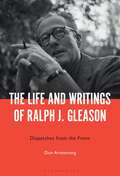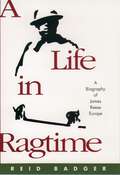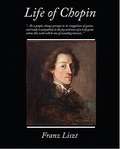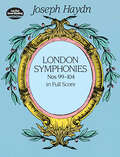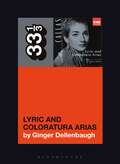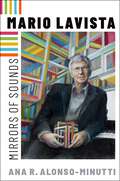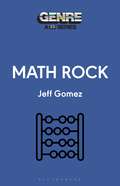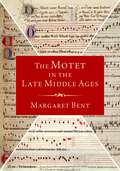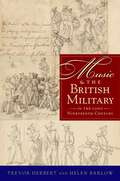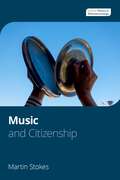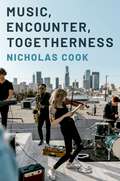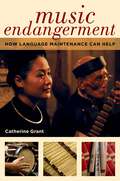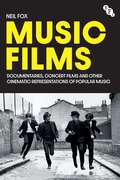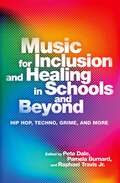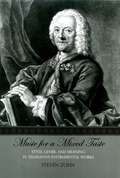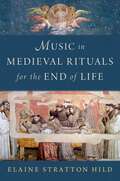- Table View
- List View
The Life and Writings of Ralph J. Gleason: Dispatches from the Front
by Professor. Don ArmstrongDiscover the enthralling world of Ralph J. Gleason, a pioneering music journalist who expanded the possibilities of the newspaper music column, sparked the San Francisco jazz and rock scenes, and co-founded Rolling Stone magazine. Gleason not only reported on but influenced the trajectory of popular music. He alone chronicled the unparalleled evolution of popular music from the 1930s into the 1970s, and while doing so, interviewed and befriended many trailblazers such as Miles Davis, Dizzy Gillespie, Bob Dylan, and the Beatles. A true iconoclast, he dismantled the barriers between popular and highbrow music, and barriers separating the musical genres. He played a crucial role in shaping postwar music criticism by covering all genres and analyzing music's social, political, and historical meanings. This book uncovers never-before-seen letters, anecdotes, family accounts, and exclusive interviews to reveal one of the most intriguing personalities of the 20th century.
Life of Chopin
by Franz LisztTo a people, always prompt in its recognition of genius, and ready to sympathize in the joys and woes of a truly great artist, this work will be one of exceeding interest. It is a short, glowing, and generous sketch, from the hand of Franz Liszt, (who, considered in the double light of composer and performer, has no living equal,) of the original and romantic Chopin; the most ethereal, subtle, and delicate among our modern tone-poets. It is a rare thing for a great artist to write on art, to leave the passionate worlds of sounds or colors for the colder realm of words; rarer still for him to abdicate, even temporarily, his own throne, to stand patiently and hold aloft the blazing torch of his own genius, to illume the gloomy grave of another: yet this has Liszt done through love for Chopin.
Little Richard's Here's Little Richard (33 1/3)
by Jordan BassettFrom male bisexuality to religion in pop, Little Richard spent the 1950s pioneering ideas that are still too challenging for the mainstream. As a Black multimillionaire rock star, he was the most exciting person on the planet between 1955 and 1957, the years in which his seismic debut album was created.Featuring new interviews with famous fans including Sir Elton John, Dave Grohl, Joan Jett and Nile Rodgers, this is the first in-depth look at Here's Little Richard since Richard Penniman's death in May 2020. The book explores his roots in the queer underground of the American South, a scene so progressive you'd scarcely believe it thrived seven decades ago, and early rebel music such as jump blues, which soon collided with the emerging juggernaut that was rock'n'roll. When that weird alchemy occurred, the self-proclaimed Living Flame was ready to spark the likes of The Beatles, David Bowie and Prince into existence. Those close to the tale pinpoint the ways in which 'Long Tall Sally' and 'Tutti Frutti' remain omnipresent – and why the latter was the 'WAP' of its day. This is the story of how Little Richard changed the world in 28 minutes and 30 seconds. A-wop-bop-a-loo-bop-a-lop-bam-boom!
London Symphonies Nos. 99-104 in Full Score
by Joseph HaydnIt was in his monumental 12 "London" symphonies, composed between 1791 and 1795, that Haydn shaped the early form of the symphony and set the standard for later composers. According to the New Grove's Dictionary of Music and Musicians, the appeal of these works stems from their stature as "grand" symphonies, embodying a "broader presentation of musical ideas" and "themes and motifs of a basic simplicity and immediate appeal."The present volume contains the last six symphonies in the series, including the lively "Military" Symphony (No. 100), the delightful "Clock" Symphony (No. 101), and the world-famous "London" Symphony (No. 104).Scores included in this volume are Symphony No. 99 in E-flat Major; Symphony No. 100 in G Major ("Military"); Symphony No. 101 in D Major ("The Clock"); Symphony No. 102 in B-flat Major; Symphony No. 103 in E-flat Major ("Dumroll"); and Symphony No. 104 in D Major ("London").The attractive qualities of these works have made them perennial favorites with musicians and concertgoers for over two hundred years. Now music lovers can study and enjoy the elegant structure and polished orchestration of these enduring masterpieces in this authoritative full-score edition.
Madeleine Dring: Lady Composer (Clemson University Press)
by Wanda Brister Jay RosenblattMadeleine Dring: Lady Composer is a biography that examines the British composer's life and music, supported by extensive archival research and primary sources. With London at its center, the story of Dring’s life follows her through formal training in the Junior Department of the Royal College of Music, the horrors of World War II, the lively atmosphere of revues in the West End, the lack of recognition during her final years, and her premature death from a brain aneurysm at the age of fifty-three. Her contributions to the diverse musical worlds of popular song, serious music, radio, and television are surveyed, with attention to the qualities that characterize her distinctive musical style. The narrative arc is compelling: education as a classical composer, success on the popular stage, return to “serious” composition, and death when her art was at the highest level. An underlying theme is the encouragement and success Dring experienced in a profession that is typically the domain of men. Her achievement as a composer is due to the excellence of her music, which is increasingly being appreciated for its imagination and sophistication, as evidenced by numerous performances and recordings.
Maria Callas's Lyric and Coloratura Arias (33 1/3)
by Ginger DellenbaughMore than 40 years after her death, the legend of Maria Callas, “La Divina Assoluta,” remains unsurpassed. Much has been written about her sensational opera career and fraught private life, from her definitive mastery of iconic opera roles to her love affairs and tantrums. The prototype for the 20th century celebrity diva, Callas emblematizes the cliche of tormented talent – genius in the ring with catastrophe. Her extraordinary voice, in particular, has become an object of cult-like adoration and cultural significance almost with a life of its own: as fetish object, as sophisticated sonic signifier, and most recently, as the lifeblood for a Callas hologram. Such adoration is not without consequences. When Callas is transformed into a vessel for such transcendent magic, it overshadows what is perhaps her most superhuman ability – the masterful technique she deployed to shape and craft her astounding instrument. Singing bodies are working bodies, enacting an intimate and complex form of artistic labor and cultural signification. Using one of Callas's first recital recordings from 1954, this book envisions each aria as a lens to examine various aspects of vocalization and cultural reception of the feminized voice in both classical and pop culture, from Homer's Sirens to Star Trek. With references to works by Marina Abramovic, Charles Baudelaire, Michel Chion, Wayne Koestenbaum, Greil Marcus, and Farah Jasmine Griffin, as well as films by Pier Paolo Pasolini, Jonathan Demme, and Rainer Werner Fassbinder, each chapter explores phenomena unique to the singing voice, including the operatic screaming point, the politics of listening, and the singing simulacrum.
Mario Lavista: Mirrors of Sounds (Currents in Latin American and Iberian Music)
by Ana R. Alonso-MinuttiThis is an open access title available under the terms of a CC BY-NC-ND 4.0 International license. It is free to read at Oxford Scholarship Online and offered as a free PDF download from OUP and selected open access locations. Composer, pianist, editor, writer, and pedagogue Mario Lavista (1943-2021) was a central figure of the cultural and artistic scene in Mexico and one of the leading Ibero-American composers of his generation. His music is often described as evocative and poetic, noted for his meticulous attention to timbre and motivic permutation, and his creative trajectory was characterized by its intersections with the other arts, particularly poetry and painting. Lavista was a relational composer; he did not write music as a private enterprise but for and alongside people with whom he established close relations. Understanding analysis as an affective practice, author Ana R. Alonso-Minutti explores the intertextual connections between the multiple texts--musical or otherwise--that are present in Lavista's music. Alonso-Minutti argues that, through adopting an interdisciplinary and transhistorical approach to music composition, Lavista forged a cosmopolitan imaginary that challenged stereotypes of what Mexican music should sound like. This imaginary becomes a strategy of resistance against imperialist agendas placed upon postcolonial peripheries. Departing from traditional biographical and chronological frameworks that exalt masters and masterworks, the author offers a nuanced, personal narrative informed by conversations with composers, performers, artists, choreographers, poets, writers, and filmmakers. Through an innovative mosaic of methodologies, from archival work, to musical and intertextual analysis, oral history, and (auto)ethnography, this book is the first in-depth study of Lavista's compositional career and offers a contextual panorama of the contemporary music scene in Mexico
The Marqu?s, the Divas, and the Castrati: Gaspar de Haro y Guzm?n and Opera in the Early Modern Spanish Orbit
by Louise K. SteinThis is an open access title available under the terms of a CC BY-NC-ND 4.0 International licence. It is free to read on the Oxford Academic platform and offered as a free PDF download from OUP and selected open access locations. During a crucial period in opera's development as a genre and as a business, the flamboyantly libertine Spanish aristocrat Gaspar de Haro y Guzm?n (1629-87), Marqu?s de Heliche and del Carpio, influenced operatic practices and productions for both Italian and Hispanic operas. A voracious collector of books and antiquities and famed connoisseur of visual art, the marqu?s financed operas in both Spain and Italy and further shaped them through his ideas, energy, and politics. His legacy also brought forth the first operas of the Americas, as posthumous revivals of the operatic genres he nurtured appeared in the Americas less than fifteen years after his death. In this book, author Louise K. Stein follows the trajectory of this first operatic producer to have shaped opera in two different worlds--Europe and the Americas--and in doing so, advances our musical and historical understanding of seventeenth- and early eighteenth-century opera and cultural encounter. Each chapter focuses on different productions spearheaded by the Marqu?s in Madrid, Rome, and Naples during his lifetime, with the final chapter considering how his influence continued in operatic productions in Lima, Mexico City, and other regions of New Spain after his death. Alongside this portrait of the distinguish patron of the arts, Stein shows how conventions of musical dramaturgy for both private and commercial opera were developed within a consistent politics of production across the far-flung administrative centers of the Spanish empire in the years 1650-1730. She reveals the place of opera within the siglo de oro (Golden Age) of Hispanic theatre and delves deeply into how the Marqu?s became the principal patron of Alessandro Scarlatti in Italy after his time in Rome, sparking a reliable production system for Italian opera in Naples. Stein also addresses gendered performance--how beliefs about female fertility conditioned listeners and shaped the operatic genre--and advances the concept of the "womanly voice" in the first extant Hispanic operas, the Italian operas produced in Naples between 1683 and 1687, and the first operas of the Americas from 1701 to 1730.
Math Rock (Genre: A 33 1/3 Series)
by Jeff GomezMath rock sounds like blueprints look: exact, precise, architectural. This trance-like progressive metal music with indie rock and jazz influences has been captivating and challenging listeners for decades. Bands associated with the genre include King Crimson, Black Flag, Don Caballero, Slint, American Football, Toe, Elephant Gym, Covet, and thousands more. In an online age of bedroom producers and sampled beats and loops, math rock is music that is absolutely and resolutely played: men and woman in rooms with instruments creating chaos, beauty, and beautiful chaos.This is the first book-length look at the global phenomenon. Containing interviews with prominent musicians, producers, and critics spanning the globe, Math Rock will delight longtime fans while also serving as a primer for those who want to delve deeper. It shows why and how an intellectually complex, largely faceless, and almost entirely instrumental form of music has been capturing the attention of listeners for 50 years-and counting.
Melanesian Mainstream: Stringband Music and Identity in Vanuatu (Pacific Perspectives: Studies of the European Society for Oceanists #11)
by Sebastian EllerichCitizens of Vanuatu (ni-Vanuatu) perceive stringband music as a marker of national identity, an indicator of their cultural, stylistic, and musical heritage. Through extensive field and ethnographic research, Melanesian Mainstream offers a detailed historical record of the roots, context, evolution, and impact of stringband music. Beyond chronicling the genre’s history and cultural significance, this thorough monograph positions the genre’s musical hybridity, communal lyrics, and unique organizational structures as key factors in the anthropological understanding of ni-Vanuatu socio-cultural history.
Melanesian Mainstream: Stringband Music and Identity in Vanuatu (Pacific Perspectives: Studies of the European Society for Oceanists #11)
by Sebastian EllerichCitizens of Vanuatu (ni-Vanuatu) perceive stringband music as a marker of national identity, an indicator of their cultural, stylistic, and musical heritage. Through extensive field and ethnographic research, Melanesian Mainstream offers a detailed historical record of the roots, context, evolution, and impact of stringband music. Beyond chronicling the genre’s history and cultural significance, this thorough monograph positions the genre’s musical hybridity, communal lyrics, and unique organizational structures as key factors in the anthropological understanding of ni-Vanuatu socio-cultural history.
The Motet in the Late Middle Ages
by Margaret BentA unique capacity of measured polyphony is to give precisely fixed places not only to musical notes, but also to individual words in relation to them and each other. The Motet in the Late Middle Ages offers innovative approaches to the equal partnership of music and texts in motets of the fourteenth century and beyond, showcasing the imaginative opportunities afforded by this literal kind of intertextuality, and yielding a very different narrative from the common complaint that different simultaneous texts make motets incomprehensible. As leading musicologist Margaret Bent asserts, they simply require a different approach to preparation and listening. In this book, Bent examines the words and music of motets from many different angles: foundational verbal quotations and pre-existent chant excerpts and their contexts, citations both of words and music from other compositions, function, dating, structure, theory, and number symbolism. Individual studies of these original creations tease out a range of strategies, ingenuity, playfulness, striking juxtapositions, and even subversion. Half of the thirty-two chapters consist of new material; the other half are substantially revised and updated versions of previously published articles and chapters, organized into seven Parts. With new analyses of text and music together, new datings, new attributions, and new hypotheses about origins and interrelationships, Bent uncovers little-explored dimensions, provides a window into the craft and thought processes of medieval composers, and opens up many directions for future work.
The Motet in the Late Middle Ages
by Margaret BentA unique capacity of measured polyphony is to give precisely fixed places not only to musical notes, but also to individual words in relation to them and each other. The Motet in the Late Middle Ages offers innovative approaches to the equal partnership of music and texts in motets of the fourteenth century and beyond, showcasing the imaginative opportunities afforded by this literal kind of intertextuality, and yielding a very different narrative from the common complaint that different simultaneous texts make motets incomprehensible. As leading musicologist Margaret Bent asserts, they simply require a different approach to preparation and listening. In this book, Bent examines the words and music of motets from many different angles: foundational verbal quotations and pre-existent chant excerpts and their contexts, citations both of words and music from other compositions, function, dating, structure, theory, and number symbolism. Individual studies of these original creations tease out a range of strategies, ingenuity, playfulness, striking juxtapositions, and even subversion. Half of the thirty-two chapters consist of new material; the other half are substantially revised and updated versions of previously published articles and chapters, organized into seven Parts. With new analyses of text and music together, new datings, new attributions, and new hypotheses about origins and interrelationships, Bent uncovers little-explored dimensions, provides a window into the craft and thought processes of medieval composers, and opens up many directions for future work.
Music: Antiquity and Its Legacy (Ancients and Moderns)
by Dr Eleonora RocconiThis book explores the pivotal role played by ancient mousike-in all its facets-in the development of musical practices and ideas throughout history. Since antiquity, music has consistently played a significant role in social and cultural life, and although the terms in which it is expressed and the cultural meanings it conveys vary dramatically across different times and geographies, the influence of the ancient Greek concept on modern Western notions is nevertheless striking. In a series of lucid and engaging thematic chapters, Eleonora Rocconi surveys the roles and functions of music from classical antiquity, through the Renaissance and early modern eras, and up to the present day. The discussion is structured around the key concepts, theoretical models, and aesthetic issues at play - from the educational and therapeutic value of music to its place in the ideal of cosmic harmony and its relationship to the senses and emotions - as well as the function of music in debates around individual and cultural identity. What emerges is a timely reassessment of the paradigmatic value of the Greek model in the musical reception of antiquity in different historical periods. It highlights the ongoing contribution of mousike to modern cultural debates within the realms of classics, musicology, philosophy, aesthetics, anthropology, performance, and cultural studies, as well as in artistic environments, and offers a clear and comprehensive account of its inexhaustible source of inspiration for musicians, theorists, scholars, and antiquarians across the centuries.
Music and Citizenship (Oxford Theory in Ethnomusicology)
by Martin StokesCritical citizenship practices and the language of today's populism have never been more sharply opposed. Today's insistent efforts to anchor citizenship narratives in national belonging now confront a variety of 'flexible' or 'differentiated' citizenships - plural, performative, and decentered practices of rights claiming mutually defining 'the political', its subjects, and its others on a variety of scales. They confront, too, critiques of citizenship in totalitarian or neoliberal governmentality that derive from Foucault, Agamben, and Arendt and have become pressing today in proliferating states of emergency and exception and the growing ranks of non-citizens. How should these debates be configured now? And what place does music have in them? In Music and Citizenship, author Martin Stokes argues that music has for a long time been entangled with debates about citizenship and citizenly identities, though for various reasons this entanglement has been insufficiently recognized. Citizenship and citizenly identity debates, for their part, have important implications for the way we think about music in relation to politics, identity, and scholarly practice. Stokes's particular claim is that ethnomusicology has for too long configured relationships between music, society, and reflective and critical practice in terms of identity paradigms. The rejection of these identity paradigms in recent years has taken the form of a post- or anti-humanism that is equally problematic. This book challenges the conventional understanding of citizenship in terms of nationalism and national identity though the examination of case studies from across Latin America, Africa, Asia, and Europe. In this way, this volume departs from an earlier ethnomusicology preoccupied with belonging and cultural participation in the nation-state. Citizenship-the fantasy, according to some definitions, of political community without outsiders-suggests, in this book, a different space in which one might configure such relations, one more satisfactorily, and energetically, oriented to questions about musical ecology, sustainability, democracy, and inclusivity.
Music and Cosmopolitanism: Rio de Janeiro at the Turn of the 20th Century (Currents in Latin American and Iberian Music)
by Cristina MagaldiMusic and Cosmopolitanism is a musical portrait of a city-Rio de Janeiro. Award-winning author Cristina Magaldi takes readers on an auditory tour through the city's early post-Imperial years, a period of crucial transition, as she surveys the city's variegated 'soundscape.' With visits to opera theaters and dance halls, and from symphony concerts to the cabaret, music halls, and the street, Magaldi moves through a gamut of musical expressions in Rio de Janeiro during these critical years of change. Her investigations demonstrate that the city's musical practices were articulated within a cosmopolitan context shared by residents in cities in the Americas and Europe, as she examines the musical and cultural interactions that resulted from early processes of urbanization, globalization, and the circulation of technology and information into and out of the Brazilian capital. While Rio de Janeiro's particular geography, urban spaces, and specific social and ethnic interactions all played roles in characterizing unique local musical practices, Music and Cosmopolitanism focuses on how these practices were linked to and fueled by the circulation of music on the international stage. To understand music and performance as part of a larger system of human connections and disconnections that are always in motion, this book offers a story of musical Rio de Janeiro that was built as much as, or perhaps more so, from the outside in than from within its socio-historical and cultural contexts - a city that grew to become one place containing many worlds.
Music, Encounter, Togetherness
by Nicholas CookIn today's technological and globalised world, music remains a basic dimension of society. Music, Encounter, Togetherness outlines a relational approach to music that creates space for both human agency and social relationship. Throughout the book, author Nicholas Cook puts Euro-American musical traditions into dialogue with other world music cultures, complementing theory-driven approaches with comprehensive case studies ranging from late eighteenth-century India to contemporary China, and from Debussy's encounter with Javanese music and dance to cross-cultural musicking in Australia and in cyberspace. Through these examples, Cook examines how music affords interpersonal relationship and social togetherness, and what happens when musicians from different cultures interact. Central to the book is the idea of encounter, which highlights the dynamic and processual nature of musicking, as much in therapy or at home as in the jazz club or concert hall. Western musicologists have traditionally thought of music as primarily a repertory of objects; Cook illustrates how thinking of it in processual terms--through an expanded idea of performance--can make as much sense of Western art music as of other traditions. In basing an understanding of music on acts rather than objects and focussing on people and their relationships rather than on the impersonal forces of evolutionary or stylistic histories, the book opens up ways of thinking that counter some of the dehumanising aspects of musical thinking and practice in global modernity.
Music Films: Documentaries, Concert Films and Other Cinematic Representations of Popular Music
by Neil FoxIn Music Films, Neil Fox considers a broad range of music documentaries, delving into their cinematic style, political undertones, racial dynamics, and gender representations, in order to assess their role in the cultivation of myth.Combining historical and critical analyses, and drawing on film and music criticism, Fox examines renowned music films such as A Hard Day's Night (1964), Dig! (2004), and Amazing Grace (2006), critically lauded works like Milford Graves Full Mantis (2018) and Mistaken for Strangers (2013), and lesser-studied films including Jazz on a Summer's Day (1959) and Ornette: Made in America (1985). In doing so, he offers a comprehensive overview of the genre, situating these films within their wider cultural contexts and highlighting their formal and thematic innovations.Discussions in the book span topics from concert filmmaking to music production, the music industry, touring, and filmic representations of authenticity and truth. Overall, Music Films traces the evolution of the genre, highlighting its cultural significance and connection to broader societal phenomena.
Music for Inclusion and Healing in Schools and Beyond: Hip Hop, Techno, Grime, and More
Contemporary popular musics such as hip hop, techno, grime, EDM, drill, house and so on are among the most listened to in the world and yet, typically, they are barely covered in the music classroom if at all. This needs to be better reflected in educational, cultural, and social terms. In wider society, these musics are often treated as if they are the causative for the social dysfunction that, in fact, they merely reflect. At the same time, projects, programmes and practices of such contemporary popular musics can and have supported wellness and healing. Editors Pete Dale, Pamela Burnard, and Raphael Travis Jr. argue that there is huge potential here for enhanced inclusion. Music for Inclusion and Healing in Schools and Beyond explains that when this music is included in the school curriculum or utilised in therapeutic contexts, huge leaps in healing and wellness can be achieved, as well as educational attainment and enjoyment in school contexts. This unique book seeks to account for those positive impacts, theorise them and help to extend and advance their impact. Contributing authors invite readers to re-think the possibilities and potentials for contemporary popular musics to gain the prestige that their actual popularity would suggest they should already command. The various contributors of this book are from diverse ethnic, social and academic backgrounds, and this title includes several chapters from practitioners who have not written about the work they do before now. Readers will learn not only about the impact of projects that utilize such music but also ideas about how that impact can best be measured.
Music in Medieval Rituals for the End of Life
by Elaine Stratton HildFor centuries of European history, singing for a person at the moment of death was considered to be the ideal accompaniment to a life's ending. In Music in Medieval Rituals for the End of Life, author Elaine Stratton Hild examines and recovers the chants sung for the dying during the Middle Ages, beginning in the late eighth century. Along with the first editions of these melodies, she offers considerations of the functions that music played within the deathbed rituals, arguing that the chants served as vehicles with which communities offered comfort to a dying person. The book presents close readings of rituals from diverse communities, each as they appear in a single source. The rituals' chants are transcribed into modern notation and analyzed, both for their text-music relationships and for their functions within the rituals. Hild shows that within the widespread practice, local versions of the liturgies--along with their chant repertories--remained unstandardized throughout the Middle Ages. Yet some commonalities are evident among these varied local practices. One is the use of song. Beginning in the ninth century, sources most often prescribe chant, not the Eucharist, for the final moments of life. Another commonality is the positive depiction of the afterlife conveyed by the chants. Created for the powerful and the poor, the educated and the uneducated, women and men, monastics, clerics, and laity, these manuscripts offer a glimpse into the religious practices that distinguished communities from one another and also bound them together within a single tradition.
